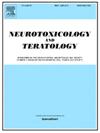新生儿七氟醚暴露诱导婴儿恒河猴血浆炎症生物标志物。
IF 2.8
3区 医学
Q3 NEUROSCIENCES
引用次数: 0
摘要
动物模型和人体研究表明,在婴儿期接受全身麻醉会导致长期的神经认知障碍。由于每年有数以百万计的儿童接受需要麻醉的手术,因此研究麻醉诱导的神经毒性机制以最终找到保护脆弱的发育中的大脑的方法是很重要的。动物模型在这项研究中发挥了关键作用,并表明新生儿全麻暴露会导致神经元凋亡、长期线粒体功能障碍和星形胶质细胞增生。目前的研究涉及恒河猴模型,反复接触七氟醚已被证明会产生认知缺陷、行为改变和线粒体损伤。本研究旨在调查延长七氟醚暴露是否会引起外周血样本的炎症。结果发现,七氟醚暴露导致外周炎症标志物水平的改变。具体来说,白细胞介素6 (IL-6)在七氟醚暴露后立即升高,但在暴露后24小时没有升高。暴露24小时后收集的血浆样本显示粒细胞巨噬细胞集落刺激因子(GM-CSF)升高,但单核细胞趋化蛋白-4 (MCP-4)和干扰素γ诱导蛋白10 (IP-10)水平降低。这些标志物的变化与认知障碍有关,这些数据表明,在临床人群中,血浆细胞因子和趋化因子水平是研究麻醉诱导炎症的一个很好的潜在介质。本文章由计算机程序翻译,如有差异,请以英文原文为准。
Neonatal sevoflurane exposure induces plasma biomarkers of inflammation in infant rhesus macaques
Animal models and human studies suggest that general anesthesia exposure during infancy results in long-lasting neurocognitive impairments. Because millions of children each year undergo procedures that require anesthesia, it is important to investigate the mechanism of anesthesia induced neurotoxicity to ultimately develop ways to protect the vulnerable developing brain. Animal models have played a key role in this investigation and have shown that neonatal general anesthesia exposure results in neuronal apoptosis, long-term mitochondrial dysfunction, and astrogliosis. The current study involved a rhesus macaque model of repeated sevoflurane exposure that has been shown to produce cognitive deficits, behavioral changes, and mitochondrial damage. This study sought to investigate whether prolonged sevoflurane exposure induced inflammation as measured in peripheral blood samples. Results found that sevoflurane exposure resulted in changing levels of inflammatory markers in the periphery. Specifically, interleukin 6 (IL-6) was increased immediately following sevoflurane exposure, but not at 24-h post-exposure. Plasma samples collected 24-h after exposure revealed increased granulocyte macrophage colony-stimulating factor (GM-CSF), but decreased monocyte chemoattractant protein-4 (MCP-4) and interferon gamma-induced protein 10 (IP-10) levels. Changes in these markers have been linked to cognitive impairment, and together these data suggest that plasma levels of cytokines and chemokines are a good potential medium to investigate anesthesia-induced inflammation in clinical populations.
求助全文
通过发布文献求助,成功后即可免费获取论文全文。
去求助
来源期刊
CiteScore
5.60
自引率
10.30%
发文量
48
审稿时长
58 days
期刊介绍:
Neurotoxicology and Teratology provides a forum for publishing new information regarding the effects of chemical and physical agents on the developing, adult or aging nervous system. In this context, the fields of neurotoxicology and teratology include studies of agent-induced alterations of nervous system function, with a focus on behavioral outcomes and their underlying physiological and neurochemical mechanisms. The Journal publishes original, peer-reviewed Research Reports of experimental, clinical, and epidemiological studies that address the neurotoxicity and/or functional teratology of pesticides, solvents, heavy metals, nanomaterials, organometals, industrial compounds, mixtures, drugs of abuse, pharmaceuticals, animal and plant toxins, atmospheric reaction products, and physical agents such as radiation and noise. These reports include traditional mammalian neurotoxicology experiments, human studies, studies using non-mammalian animal models, and mechanistic studies in vivo or in vitro. Special Issues, Reviews, Commentaries, Meeting Reports, and Symposium Papers provide timely updates on areas that have reached a critical point of synthesis, on aspects of a scientific field undergoing rapid change, or on areas that present special methodological or interpretive problems. Theoretical Articles address concepts and potential mechanisms underlying actions of agents of interest in the nervous system. The Journal also publishes Brief Communications that concisely describe a new method, technique, apparatus, or experimental result.

 求助内容:
求助内容: 应助结果提醒方式:
应助结果提醒方式:


